Tussock Moth Caterpillars in Florida
Orgyia detrita,
Orgyia leucostigma, and
Orgyia definita
(Lepidoptera: Lymantriidae)


Tussock moth caterpillars are occasionally abundant and widespread in northcentral Florida. Besides the annoying presence of numerous hairy caterpillars, these insects may spin their difficult-to-remove cocoons on houses, boats, picnic tables and other outdoor articles. Feeding by the caterpillars usually has little impact on oak trees, their preferred hosts, but wind-blown caterpillars may land on and defoliate small trees and shrubs around the yard.
Life Cycle: Hatch from the overwintering eggs starts around March 1 when oak trees are flushing. Caterpillars feed and grow over a period of 4 to 6 weeks. The 2-week long pupal stage occurs from early to mid April. Male moths emerge and fly to the wingless females from mid April into early May. Females lay a mass of eggs on their cocoons. Depending on the species, there is either no further activity until the following spring, or the eggs will hatch after a few weeks and produce another generation.
Identification: The most common of the 3 Orgyia species we have in Florida is Orgyia detrita. Caterpillars of this species generally are dark bodied with a red head, 2 black "hair pencils" projecting forward like antennae, 4 dense tufts of hair (tussocks) on the back, and a fluffy tuft projecting to the rear like a tail. Unique to this species are the orange-colored spots along the back and sides. Caterpillars of the whitemarked tussock moth, Orgyia leucostigma, are similar looking but are distinguished by their lighter body color and yellow spots. The rarely-encountered third species, Orgyia definita, has a yellow or tan head to go with its pale body, hair pencils and tussocks.
Management Recommendations: Persons disturbed by tussock moth caterpillars may wish to do some of the following:
| Egg Mass on Cocoon | |
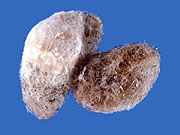 |
Eggs are deposited on cocoons by the wingless females in late April and early May. During oviposition, females cover the egg mass with hairs from their abdomen. Note the hair-covered egg mass on the cocoon on the left. |
| Spring Hatch | |
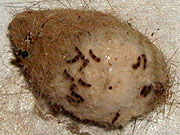 |
Hatching occurs during late February and early March at the same time
that oak tress are beginning to leaf out. The neonates disperse from the
egg mass in search of expanding leaves on which they feed.
Digital image by J. L. Foltz, U. F. Entomology Dept. |
| Young Caterpillar | |
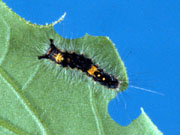 |
After feeding for several days, neonates molt to the second instar pictured here. These young caterpillars are easily recognized as tussock moths by the short "hair pencils" just behind the head, the tussocks beginning to form on the first abdominal segments, the sparse hairs along the body, and the brightly colored glands on the dorsum of abdominal segments 6 and 7. The bright yellow-orange markings readily distinguish Orgyia detrita from the other two species of Orgyia occurring in Florida. |
| Half-grown Caterpillar | |
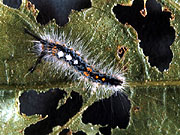 |
After several weeks of feeding the caterpillars will appear with the markings and coloration of the early 4th instar shown here. The hair pencils are longer and three of the 4 tussocks are now prominent. Note also that at this size the caterpillars feed by chewing holes in the leaves rather than just nibbling along the leaf margins. |
| Mature Caterpillar | |
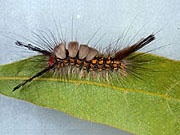 |
Fully-grown larvae are 1 to 1.5 inches long. Most are dark bodied with
orange spots as illustrated here. Some, however, are light bodied and look
much like caterpillars of the whitemarked tussock moth, Orgyia leucostigma.
Mature larvae cease feeding and disperse to seek protected locations for
spinning their silken, hair-covered cocoons.
Photo credit: J. F. Butler, U. F. Entomology Dept. |
| Pupal Stage | |
 |
After spinning cocoons, larvae shed their skins for the dramatic metamorphosis from caterpillar to moth. Initially cream-colored, pupae gradually darken during the 10 to 14 day process. Note the hairy body and the tussocks on the dorsum. Note also the envelopes around the feathery antennae and large wings of the male. Females (not pictured) have simple, thread-like antennae and no wings. |
| Adult Female | |
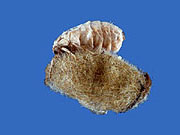 |
Females of all Orgyia tussock moths have no wings, so casual observers often do not recognize them as being adult moths. The female emerges through a hole in the end of the cocoon and then sits upon it. In the middle of the night she produces pheromones to attract flying males. After mating, she lays her eggs and dies. |
| Adult Male | |
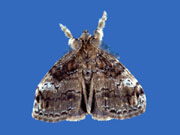 |
Male moths often rest with the posture illustrated here. The wings are folded back, appressed to the abdomen, and form a broad triangle. The hairy front legs are extended forward while the large bipectinate antennae are held back against the wings. Males rest during the day and fly about seeking females during the night. Although individuals live just a few days, the flight period lasts about 3 weeks. My observations spanning eight years in Gainesville, Florida show males first appearing between April 16 and May 5. The flight period lasts approximately 3 weeks. |
| Identification | |
 |
The whitemarked tussock moth has a life cycle similar to that of
Orgyia detrita. One distinguishing characteristic of this species
is that females do not cover the eggs with abdominal hairs. Instead, we
see a frothy-white egg mass on top of the cocoon.
Photo credit: J. F. Butler, U. F. Entomology Dept. |
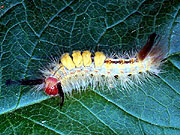 |
Caterpillars of the whitemarked tussock moth, Orgyia leucostigma, look similar to Orgyia detrita, but are distinguished by their lighter body color and yellow spots. This species has two generations per year. |
|
http://www.ag.auburn.edu/dept/entplp/bulletins/whitemarkedtussock/whitemarkedtussock.htm |
| Identification | |
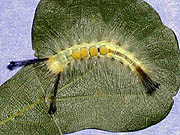 |
Caterpillars of Orgyia definita are readily identified by the
yellow color of the head, prothoracic plate and dorsal glands. The hair
pencils are less fully developed than in the other species. The hair on the body is
entirely whitish and the verrucae (the wart-like structures
along the body) are pale yellow.
Orgyia definita is most common in the New England and Middle Atlantic states and is rarely collected along the southern Coastal Plain. Entomologists who encounter this yellowheaded Orgyia caterpillar are asked to email their observations to John Foltz so that the geographic and temporal occurrence of this species can be documented. From digital image by J. L. Foltz, U. F. Entomology Dept. |
| Parasitized Larva | |
| There are many natural enemies of caterpillars feeding on leaves. In
addition to predation by birds, reptiles and insects, larvae are
parasitized by various flies and wasps. This picture shows a tussock moth
cadaver and the puparium of a tachinid fly. Some flies lay their eggs on
leaves where they will be eaten by caterpillars. After hatching in the
gut, the maggots feed on the internal tissues of their host. The
fully-grown maggots then emerge and normally drop to the ground to pupate.
From digital image by J. L. Foltz, U. F. Entomology Dept. | |
| Cocoon | |
| The silken cocoons of Orgyia definita are distinguished from those of the
other two species by the near absence of caterpillar hairs. The fine white body hairs
and occasional black hairs from the hair pencils barely conceal the pupa within the cocoon.
From digital image by J. L. Foltz, U. F. Entomology Dept. | |
|
For information on other forest and shade tree insects in Florida
go to: http://eny3541.ifas.ufl.edu/ |